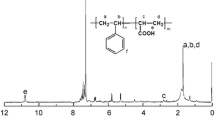Abstract
The 60Co-gamma rays radiation-induced and free radical-initiated copolymerizations of allyl glycidyl ether with styrene were studied comparatively. The latter was carried out at 60 °C for 1, 3, 5 and 7 days using azobis(isobutyronitrile) as a radical initiator, while in the first one the samples were irradiated at the different absorbed doses of 55, 110 and 165 kGy. Changes in chemical structure during copolymerization in both methods were analyzed by using proton nuclear magnetic resonance spectroscopy (1H NMR) and Fourier transform infrared spectroscopy. Thermal properties of the products were examined by means of thermogravimetry. Thermal stability values of poly(allyl glycidyl ether-co-styrene) (poly(AGE-co-St)) samples obtained by radical polymerization were quite similar to those of samples obtained by irradiation. The molecular weights (M w and M n ) of the copolymers were determined by using gel permeation chromatography. The results showed that the polymerization method affects the polydispersity index of the copolymers. The results indicated that the radiation-induced copolymerization had a lower yield than that of radical initiator copolymerization.






Similar content being viewed by others
References
Akhavan J, Kronfli E, Waring SC (2003) Effect of gamma radiation on polyNIMMO. Polymer 44:7617–7624
Dedgaonkar VG, Navle PB, Shrotri PG (1996) Radiation effects on aging behaviour of oligobutadiene-base urethane polymer. Radiat Phys Chem 48:333–335
Fintzou AT, Badeka AV, Kontominas MG, Riganakos KA (2006) Changes in physicochemical and mechanical properties of γ-irradiated polypropylene syringes as a function of irradiation dose. Radiat Phys Chem 75:87–97
Albano C, Reyes J, Ichazo M, González J, Hernández M, Rodríguez M (2003) Mechanical, thermal and morphological behaviour of the polystyrene/polypropylene (80/20) blend, irradiated with γ-rays at low doses (0–70 kGy). Polym Degrad Stab 80:251–261
Torikai A, Harayama K-I, Hayashi N, Mitsuoka T, Fueki K (1994) Radiation-induced degradation of poly(styrene-co-methylmethacrylate) and blends of polystyrene and polymethylmethacrylate. Radiat Phys Chem 43:493–496
Seyferth D, Son DY, Tasi M (1995) The 60Co gamma-radiation-induced polymerization of vinylalkoxysilanes. Organometallics 14:2225–2231
Galia A, Caputo G, Spadaro G, Filardo G (2002) Gamma-radiation initiated polymerization of vinylidene fluoride in dense carbon dioxide. Ind Eng Chem Res 41:5934–5940
Şolpan D, Güven O (1996) The copolymerization of allyl glycidyl ether with acrylonitrile initiated by gamma-rays. J Polym Sci Part A Polym Chem 34:833–838
Schildknecht CE (1973) Allyl compounds and their polymers (including polyolefins). Wiley, New York
Laible RC (1958) Allyl polymerizations. Chem Rev 58:807–843
Matsumoto A (2001) Polymerization of multiallyl monomers. Prog Polym Sci 26:189–257
Şolpan D, Güven O (1998) The thermal stability of copolymers of allyl alcohol with acrylonitrile and methyl methacrylate. Polym Degrad Stab 60:367–370
Nagelsdiek R, Mennicken M, Maier B, Keul H, Höcker H (2004) Synthesis of polymers containing cross-linkable groups by atom transfer radical polymerization: poly(allyl methacrylate) and copolymers of allyl methacrylate and styrene. Macromolecules 37:8923–8932
Şolpan D, Güven O (2000) Thermal stability of the copolymers of allyl glycidyl ether with acrylonitrile and methyl methacrylate obtained via gamma irradiation. Radiat Phys Chem 57:173–177
Sunder A, Türk H, Haag R, Frey H (2000) Copolymers of glycidol and glycidyl ether: design of branched polyether polyols by combination of latent AB2 and ABR monomers. Macromolecules 33:7682–7692
Wurm F, Schüle H, Frey H (2008) Amphiphilic linear-hyperbranched block copolymers with linear poly(ethylene oxide) and hyperbranched poly(carbosilane) block. Macromolecules 41:9602–9611
Xu K, Chen M, Zhang K, Hu J (2004) Synthesis and characterisation of novel epoxy resin bearing naphthyl and limonene moieties and its cured polymer. Polymer 45:1133–1140
Yang P, Wang G, Xia X, Takezawa Y, Wang H, Yamada S, Du Q, Zhong W (2008) Preparation and thermo-mechanical properties of heat-resistant epoxy/silica hybrid materials. Polym Eng Sci 48:1214–1221
Wang CS, Lee MC (1998) Synthesis and modification of a naphthalene-containing trifunctional epoxy resin for electronic applications. J Appl Polym Sci 70:1907–1921
Wan J, Li B-G, Fan H, Bu Z-Y, Xu C-J (2010) Nonisothermal reaction, thermal stability and dynamic mechanical properties of epoxy system with novel nonlinear multifunctional polyamine hardener. Thermochim Acta 511:51–58
Hsiue GH, Wei HF, Shiao SJ, Kuo WJ, Sha YA (2001) Chemical modification of dicyclopentadiene-based epoxy resins to improve compatibility and thermal properties. Polym Degrad Stab 73:309–318
Zabihia O, Mostafavi SM, Ravari F, Khodabandeh A, Hooshafza A, Zare K, Shahizadeh M (2011) The effect of zinc oxide nanoparticles on thermo-physical properties of diglycidyl ether of bisphenol A/2,2′-diamino-1,1′-binaphthalene nanocomposites. Thermochim Acta 521:49–58
Hu Z, Fan X, Zhang G (2010) Synthesis and characterization of glucose-grafted biodegradable amphiphilic glycopolymers P(AGE-glucose)-b-PLA. Carbohyd Polym 79:119–124
Hrubỳ M, Końăk Č, Ulbrich K (2005) Poly(allyl glycidyl ether)-block-poly(ethylene oxide): a novel promising polymeric intermediate for the preparation of micellar drug delivery systems. J Appl Polym Sci 95:201–211
Casarano R, Matos JR, Fantini MCA, Petri DFS (2005) Composites of allyl glycidyl ether modified polyethylene and cellulose. Polymer 46:3289–3299
Acknowledgments
One of the authors (Y. Yildirim) is thankful to the Research Fund Accountancy of Ege University for providing a partial funding for this study (2006/Fen/038).
Author information
Authors and Affiliations
Corresponding author
Rights and permissions
About this article
Cite this article
Yıldırım, Y., Balcan, M. Comparative copolymerization of allyl glycidyl ether with styrene using radiation and chemical initiation methods. Iran Polym J 22, 1–7 (2013). https://doi.org/10.1007/s13726-012-0096-0
Received:
Accepted:
Published:
Issue Date:
DOI: https://doi.org/10.1007/s13726-012-0096-0




